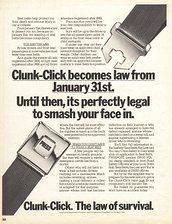
What is an Expert Witness?
27th January 2023
What is Medico-Legal Law and How Does It Impact You
1st March 202331st January 1983 is an important date in my life.
It was the last day I was working as a neurosurgical junior doctor before I started work the next day in an A&E department (as it was then called) but that is not the most important event of that day.
That day it became law to wear seat belts in the front seats of a vehicle unless you had a specific exemption.
Despite the national advertising campaign in the 1970’s fronted by the now disgraced TV personality Jimmy Saville with the catch phrase Clunk Click every trip it was still common for motorists not to wear seatbelts when driving or as a passenger.
Why was this important?
I had spent the previous 6 months as a neurosurgical junior doctor and had seen a significant number of patient suffering significant head, and often combined with facial, injuries due to their head and face hitting a hard part of the interior of their vehicle such as the steering wheel, the dashboard or the windscreen.
Often during the consultant ward rounds after reviewing the patient on the neurosurgical ward we would visit the maxillo-facial ward where those with complex facial fractures were recovering from their combined injuries.
What changed after the introduction of the seat belt law?
While I still saw a number of patients suffering with injuries from road traffic collisions while in the Emergency Department (A&E) there were far fewer significant head or facial injuries in that period.
The maxilla-facial surgeons in the hospital went as far as writing to a National Newspaper a few months after the introduction of the legislation that the number of patients with severe facial injuries had decreased to such an extent that their trainees had inadequate experience of repairing these injuries.
Why talk about the seat belt law now ?
The 40th Anniversary of this legislation means that only those over 57 could have legally driven cars where the legislation was not in force. I remember as a child riding in my father’s car which did not even have seat belts fitted but they had become compulsory part of standard fitting by the time I got my driving license and first car.
However there are still some people who drive or ride in cars without wearing their seat belts and think that with the improvement in car design, the introduction of safety cells in cars and airbags mean that the previous risks of injury from not wearing a seat belt have been reduced and they are unlikely to be severely injured by not wearing a seatbelt.
Statistics from webuyanycar.com indicate that 7% of people still do not wear seatbelts and over a third of all deaths in car accidents are caused by the lack of a seat belt. 14% of the population only occasionally wear seat belts and this rate decreases when night falls as it is more difficult to be spotted by police and thereby the thinking is reducing the risk of having to pay £100 on the spot fine minimum.
Think.gov.uk goes further stating that you are twice as likely to die if you are not wearing a seat belt. The age group least likely to wear a seat belt are the 17-34, combined with the highest accident rate.
Seat belts and whiplash
Meanwhile, the Government are trying to reduce the cost of whiplash injuries which have risen significantly after the introduction of seat belt legislation. In May 2021, legislation was introduced to impact the unacceptably high number of claims for whiplash. Between 2020 and 2021, over 500,000 claims were made. There is now a ban on settling whiplash claims without medical evidence.
However, of all the research available, there is little that accurately calculates the cost savings, and the productive work of people who do not have severe injuries and who do not die due to not wearing seatbelts.




